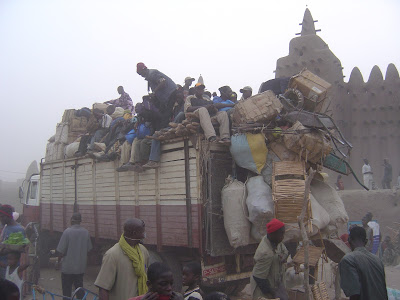The dust was choking, and after exploring a little we retreated to the courtyard of Chez Baba, a hotel near the square, for a beer (the inferior Flag instead of Castel). The sun did not set, but faded into the dust haze, as trucks were packed with goods and people. When the crowd had dispersed we moved the car to the hotel, and slept on the roof, with a fine view of the mosque and only a few mosquitoes.
From Djenne we drove into Dogon country again, taking the same route though Sanga that Stefanie and I followed last week. We camped under the ancient rocks of the escarpment, so peaceful that I could hear the sound of bat wings in the night. In the morning we spent a couple of hours fixing stuff in the car, visited by a group of small boys. They almost fought over who would do the breakfast dish washing, and in the end one passed the dirty items, one washed, one dried and one stacked the clean items. They gave the stove a good cleaning too, and ate our left over pasta.
A few miles on, we explored one of the villages, invited by a resident. He led us up a boulder track to the old village, now mostly abandoned. It has water, but the effort of carrying goods up and down has resulted in most people moving to the new village below. Only his family remain, and his wife was at work pounding couscous in their courtyard. He was very proud of his little terraces of crops, including onions, tobacco, papaya and banana, irrigated from the spring by hand using calabashes.















No comments:
Post a Comment